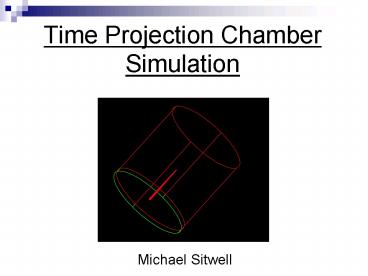Time Projection Chamber Simulation - PowerPoint PPT Presentation
Title:
Time Projection Chamber Simulation
Description:
Time Projection Chamber Simulation. Michael Sitwell. Simulation of TPC. Add ... from S.R. Elliott and P. Vogel, Ann.Rev.Nucl.Part.Sci. 52 (2002) 115. 2 spectrum ... – PowerPoint PPT presentation
Number of Views:78
Avg rating:3.0/5.0
Title: Time Projection Chamber Simulation
1
Time Projection Chamber Simulation
Michael Sitwell
2
Simulation of TPC
Add picture of TPC
3
Simulation of TPC
- Track of incident particle
- Ionization of gas
- Energy loss
- Gas normally ionized in clusters
- Recombination of electrons and ions
dE/dx
4
Simulation of TPC
- Drift of electrons produced in ionization to
readout pad - Diffusion in gas
- Multiplication of electrons
- Attachment in gas
- Avalanche area
5
Simulation of TPC
- Readout pads and wire grids
- Number and layout
- Electronic response
- Induced signals
6
Enriched Xenon Observatory
- Goal Measure the rate of neutrinoless double
beta decay to find mass scale of neutrinos - Need good energy resolution (lt1)
Add energy spectrum picture
7
EXO
- No avalanche area or multiplication
- One large readout pad
- Measures analog signal when electrons are
collected on readout pad - Alpha source inside chamber
- 5.5 MeV alpha particles produced
- Electrons from ionization produced in a constant
stream - More electrons produced at end of track
8
EXO
Ar-CH4 90-10 _at_ 2 atm
9
Simulation for EXO
- Alpha source mounted on adjustable platform
- Drift length can be set in 1 cm increments from 5
cm to 20 cm - Currently filled with 90-10 Argon methane
- Will be replaced by Xenon
Add picture
10
Geant4
Add X
- Complex geometry easy to construct
- Includes physics tables and particle interactions
- Easy event generation
- Continuously tracks all particles
- Including ions from ionization
- No physics tables for low energy ? particles
- Can't drift electrons to readout pad
Recombination
11
Garfield
- Able to simulate the drift of electrons
- Used in conjunction with Geant4 simulation
- Can only simulate electron drift
- Is unaware of ions created by incident particle
- Problem for simulating recombination
12
Geant4 GarfieldSimulation of alpha track21
electrons produced in ionization
13
Geant4 Garfield
- Currently simulates drift of each individual
electron produced in ionization - Approximately ¼ million electrons produced by
ionizing alpha particle - Too many electrons for current simulation
- A 'cluster' class is needed as a higher level
representation of electrons - Requires a large portion of Geant4 to be
rewritten
14
Stand Alone Simulation
- Takes energy steps of 4400 eV
- Subtracts step from current energy
- Finds change in range the alpha particle
- ?R Range(Energy) Range(Energy step)
- Assumes ionization accounts for all energy loss
15
Stand Alone Simulation
- ? within ?R of current position
- 4400 eV/step 22 eV/e- 200 e-/step
- are created
Add graph
- Electrons created with a flat probability
distribution within ?R - Step size is small enough that electron
distribution does not change between runs
16
Stand Alone Simulation
17
Stand Alone SimulationAlpha particle track 10o
below horizontal
Electron Density
18
Stand Alone Simulation
- e- pass wire grid induced signal on readout pad
- Integrate arrival times
- Convolute with function
f(t) t / Trise
19
Stand Alone Simulation
- e- pass hits readout pad signal from
electronics
g(t) exp(-t/tf) x ( 1-exp(-t/tr) )
- Convolute with function
Signal Decay
Rise More Gradual
20
Stand Alone SimulationAlpha particle track
parallel to readout pad
21
Stand Alone SimulationAlpha particle track
parallel to readout pad
22
Stand Alone SimulationAlpha particle track
traveling towards readout pad
23
Stand Alone SimulationAlpha particle track
traveling towards readout pad
24
Stand Alone Simulation
rise times 0 550 ns 90 250 ns
25
Comparison with Experiment
- A set of time signals in 1 increments from 0 to
90 was generated - Stored for comparison with experimental data
- A chi² fit was used to match an experimental time
signal to a signal in the generated set
26
Comparison with Experiment
27
Comparison with Experiment
28
Comparison with Experiment
29
Comparison with Experiment
30
Comparison with Experiment
- Many signals identified with angles lt 40 with a
high degree of error - Caused by high levels of noise
- Noise amplitude ? 7 of signal amplitude
31
Comparison with Experiment
32
Comparison with Experiment
- With signals identified with angles lt 40, the
rise time of the signal was compared to the
simulation's rise times to achieve a better
estimate of its angle
33
Comparison with Experiment
34
Stand Alone Simulation
- Does not account for ions produced by alpha
particle - No attachment is seen
- Results in constant number of electrons produced
35
2? mode a conventional 2nd order process
in nuclear physics
0? mode a hypothetical process can happen
only if M? ? 0 ? ?
Since helicity has to flip
Several new particles can take the place of the
virtual ? But 0?ßß decay always implies new
physics
Lepton-Photon 03
G. Gratta
35
36
2??? spectrum (normalized to 1)
0??? peak (5 FWHM) (normalized to 10-2)
Summed electron energy in units of the kinematic
endpoint (Q)
from S.R. Elliott and P. Vogel,
Ann.Rev.Nucl.Part.Sci. 52 (2002) 115.
The only effective tool here is energy resolution
37
(No Transcript)
38
(No Transcript)

